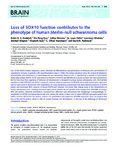Loss of SOX10 function contributes to the phenotype of human Merlin-null schwannoma cells
| dc.contributor.author | Doddrell, RDS | |
| dc.contributor.author | Dun, X-P | |
| dc.contributor.author | Shivane, A | |
| dc.contributor.author | Feltri, ML | |
| dc.contributor.author | Wrabetz, L | |
| dc.contributor.author | Wegner, M | |
| dc.contributor.author | Sock, E | |
| dc.contributor.author | Hanemann, CO | |
| dc.contributor.author | Parkinson, DB | |
| dc.date.accessioned | 2015-10-06T13:23:44Z | |
| dc.date.available | 2015-10-06T13:23:44Z | |
| dc.date.issued | 2013-02 | |
| dc.identifier.issn | 0006-8950 | |
| dc.identifier.issn | 1460-2156 | |
| dc.identifier.uri | http://hdl.handle.net/10026.1/3571 | |
| dc.description.abstract |
Loss of the Merlin tumour suppressor causes abnormal de-differentiation and proliferation of Schwann cells and formation of schwannoma tumours in patients with neurofibromatosis type 2. Within the mature peripheral nerve the normal development, differentiation and maintenance of myelinating and non-myelinating Schwann cells is regulated by a network of transcription factors that include SOX10, OCT6 (now known as POU3F1), NFATC4 and KROX20 (also known as Egr2). We have examined for the first time how their regulation of Schwann cell development is disrupted in primary human schwannoma cells. We find that induction of both KROX20 and OCT6 is impaired, whereas enforced expression of KROX20 drives both myelin gene expression and cell cycle arrest in Merlin-null cells. Importantly, we show that human schwannoma cells have reduced expression of SOX10 protein and messenger RNA. Analysis of mouse SOX10-null Schwann cells shows they display many of the characteristics of human schwannoma cells, including increased expression of platelet derived growth factor receptor beta (PDGFRB) messenger RNA and protein, enhanced proliferation, increased focal adhesions and schwannoma-like morphology. Correspondingly, reintroduction of SOX10 into human Merlin-null cells restores the ability of these cells to induce KROX20 and myelin protein zero (MPZ), localizes NFATC4 to the nucleus, reduces cell proliferation and suppresses PDGFRB expression. Thus, we propose that loss of the SOX10 protein, which is vital for normal Schwann cell development, is also key to the pathology of Merlin-null schwannoma tumours. | |
| dc.format.extent | 549-563 | |
| dc.format.medium | ||
| dc.language | en | |
| dc.language.iso | eng | |
| dc.publisher | Oxford University Press (OUP) | |
| dc.subject | Schwann | |
| dc.subject | merlin | |
| dc.subject | SOX10 | |
| dc.subject | KROX20 | |
| dc.subject | schwannoma | |
| dc.title | Loss of SOX10 function contributes to the phenotype of human Merlin-null schwannoma cells | |
| dc.type | journal-article | |
| dc.type | Article | |
| plymouth.author-url | https://www.ncbi.nlm.nih.gov/pubmed/23413263 | |
| plymouth.issue | 2 | |
| plymouth.volume | 136 | |
| plymouth.publication-status | Published | |
| plymouth.journal | Brain | |
| dc.identifier.doi | 10.1093/brain/aws353 | |
| plymouth.organisational-group | /Plymouth | |
| plymouth.organisational-group | /Plymouth/Faculty of Health | |
| plymouth.organisational-group | /Plymouth/Faculty of Health/Peninsula Medical School | |
| plymouth.organisational-group | /Plymouth/REF 2021 Researchers by UoA | |
| plymouth.organisational-group | /Plymouth/REF 2021 Researchers by UoA/UoA01 Clinical Medicine | |
| plymouth.organisational-group | /Plymouth/REF 2021 Researchers by UoA/UoA03 Allied Health Professions, Dentistry, Nursing and Pharmacy | |
| plymouth.organisational-group | /Plymouth/Research Groups | |
| plymouth.organisational-group | /Plymouth/Research Groups/Institute of Translational and Stratified Medicine (ITSMED) | |
| plymouth.organisational-group | /Plymouth/Research Groups/Institute of Translational and Stratified Medicine (ITSMED)/CBR | |
| plymouth.organisational-group | /Plymouth/Users by role | |
| plymouth.organisational-group | /Plymouth/Users by role/Academics | |
| plymouth.organisational-group | /Plymouth/Users by role/Researchers in ResearchFish submission | |
| dc.publisher.place | England | |
| dc.identifier.eissn | 1460-2156 | |
| dc.rights.embargoperiod | Not known | |
| rioxxterms.versionofrecord | 10.1093/brain/aws353 | |
| rioxxterms.licenseref.uri | http://www.rioxx.net/licenses/all-rights-reserved | |
| rioxxterms.type | Journal Article/Review |


